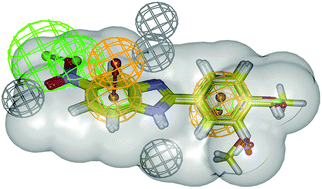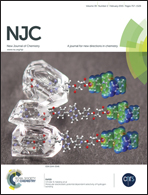An in silico protocol for identifying potential poly(ADP-ribose)polymerase-1 (PARP-1) inhibitors from chemical databases†
Abstract
Inhibitors of poly(ADP-ribose)polymerase-1 (PARP-1) are considered as potential drugs for the treatment of inflammation, cancer and neurotoxicity. In this study, ligand-based pharmacophore models were constructed to be used for virtual screening of PARP-1 inhibitors. The retrieved hits were filtered by steric constriction and docking studies. Afterwards, eight compounds, which exhibited strong interactions with the key amino acids in the PARP-1 active site, were subjected to in vitro evaluation, where compound 5 (IC50 = 0.04 ± 0.01 μM) showed PARP-1 inhibitory activity closer to that of the positive control olaparib (IC50 = 0.03 ± 0.01 μM). In addition, compounds 2–5 displayed some cytotoxic activities against the MDA-MB-231 cell line with inhibition rates of over 80% at a concentration of 100 μM. The results indicate that our screening approach has good potential in identifying PARP-1 inhibitors.


 Please wait while we load your content...
Please wait while we load your content...